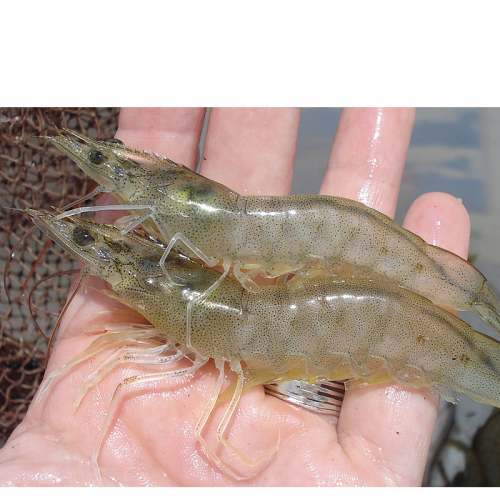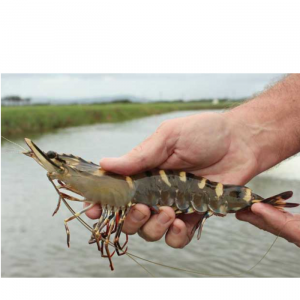
Shrimp Farming Techniques in Floating Tanks
| Mon, 01 Feb 2021 - 17:39
Designing the aquarium
Shrimp farming in floating tanks has many benefits such as: vertical walls should limit dirt and algae around the tank walls, thereby reducing tank cleaning, intestinal diseases caused by shrimp eating this dirt; The structure of the tank is floating, so there is no reverse osmosis from the outside to the inside, limiting disease infection from the outside environment. Waste is collected in the center, very convenient for siphoning, good water environmental management. Another advantage of the lake round the average area of 500 m 2 should use the staging fan less, just 2 unit ventilators 1 lake thereby saving fuel costs and also labor-saving system operation farming .
Also read: Environment, Bacterial Community Dynamics and White Feces Disease Outbreaks in Shrimp Ponds
The tank is specially designed with a round shape, built from a steel frame covered with HDPE canvas with a funnel-shaped bottom, vertical wall, an area of 500 m 2 . Some technical requirements during the installation of the aquarium include:
• The nursery tank needs to be placed on a high soil position so that the bottom of the nursery tank floats higher than the pond water so that the water can be transferred to a large pond with the pre-installed plumbing system by turning the drain valve. no loss of nursery shrimp, the transfer of shrimp also becomes much lighter;
• The circular nursery tank must have a steep slope of about 5% for easy waste collection;
• The system of floating nursery tanks should have a water tank of equal volume. To be able to replace the water supply 100% when needed, the water tank must always be treated with a clean bacteria and ensure the standards to supply water for the nursery tanks;
• The floating nursery tank is used for the nursery stage preparing to raise the meat, the farmer should use the orchid net to shield the temperature to reduce the amplitude of temperature fluctuations, partly reducing direct rainfall during heavy rain. Low cost, can be removed gradually so that shrimp accustomed to the temperature without cover, so shrimp are not subject to heat shock, ensuring survival rate;
• Shrimp should be nursed in a small area of about 100 m 3 of water to easily manage and control the environment, measure the necessary parameters without being dependent on external conditions or extreme weather, sudden changes, proactively take the time to sow phase 2 when the best preparation for the growout pond.
Also read: Effective Preservation and Use of Shrimp Feed
Shrimp farming process
According to the scientists, shrimp farming by Biofloc technology has outstanding advantages: Free ammonia (the form of toxic gas for farmed aquatic products) is converted to protein in heterotrophic microbial biomass. , gather into Biofloc suspended in water and they will become food for farmed shrimp. From there, improving the level of biosafety, reducing the risk of disease infection due to no or less water exchange in intensive shrimp ponds - semi-intensive. Moreover, farming with Biofloc technology reduces the cost of food, drugs, and antibiotics to improve product quality as well as contribute to protecting the surrounding environment, aiming to make shrimp farming more and more sustainable.
Shrimp farming in floating tanks is conducted through two stages:
Hatching stage (stage 1): Nursing density: 1,000 - 3,000 shrimp / m 2; Shrimp nursery size: PL10 - 12; Nursing time: 20-25 days when the seedlings reach 1,000-2,000 / kg; Survival rate: 90 - 95%. The purpose of shrimp rearing from PL12 to PL40: Shrimp are healthy, have high resistance, have good resistance to environmental changes and diseases, especially AHPND / EMS. Fast growth, uniform shrimp, high survival rate. Shorten the grow-out time, reduce initial farming costs, limit risks during farming, increase crops per year and increase yields. During the shrimp nursery process, farmers must strictly follow the process of treating input water through settling ponds, treatment ponds, ready ponds, finally to the culture pond. Choose quality, disease-free seed, and nurseries in tanks for 20-30 days to reach uniform sizes before releasing them into ponds.
Also read: Why Need to Add Minerals to Fish and Shrimp Feed?
Some note:
• When using a tank that is too small (less than 50 m 3 ) it can cause temperature fluctuations to occur rapidly. Therefore, it is necessary to use a large size tank with a carefully shielded roof, along with the even aeration of the pond wall.
• Environmental shock when going to phase 2: Farmers should turn the water 1 - 2 days before, open the roof so that the shrimp get used to the outside environment. San shrimp at cool weather, early morning or evening
• Ensuring good quality aeration, electricity, food, environmental testkit must be fully prepared. The care also needs someone with good technical and expertise, available 24/24 to ensure no breakdown and too long.
The commercial shrimp farming stage (phase 2): Breeding density: 100 - 300 shrimp / m 2 ; Seed size: 1,000 - 2,000 shrimp / kg; Culture time: 65 - 80 days; Harvest shrimp size: 30 - 60 shrimp / kg; Productivity: 34 - 40 tons / ha; Survival rate: 90 - 95%. During the farming process, solid waste from ponds must be carefully settled and filtered and collected regularly. After 100 days of age, shrimp with an average weight of 30 shrimp / kg received commercial shrimp. The advantage of this model is that the survival rate of shrimp is very high at 90 - 100%. Due to the continuous use of fan reversing water, the installation of a circulating system, the amount of water used can be saved, and minerals are limited.
Source: Tepbac.com






















